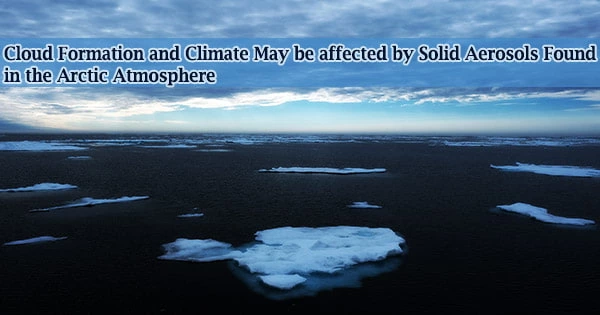The Arctic is losing sea ice at an alarming rate, and less ice means more open water, which means more gas and aerosol emissions from the ocean into the atmosphere, warming the atmosphere and making it cloudier.
When researchers from the University of Michigan’s Kerri Pratt’s lab collected aerosols from the Arctic atmosphere in summer 2015, Rachel Kirpes, a doctorate student noticed something unusual: aerosolized ammonium sulfate particles didn’t seem like conventional liquid aerosols.
Kirpes discovered that ammonium sulfate particles, which should have been liquid, were really solid while working with fellow aerosol scientist Andrew Ault. They reported the findings of the team in the Proceedings of the National Academy of Sciences.
Solid aerosols have the potential to alter cloud formation in the Arctic. Researchers expect to see more of these unusual particles created from oceanic emissions coupled with ammonia from birds as the Arctic loses ice, which will impact cloud formation and climate.
Understanding the features of aerosols in the atmosphere is also important for improving climate models’ capacity to predict current and future climate in the Arctic and beyond.
“The Arctic is warming faster than anywhere else in the world. As we have more emissions from open water in the atmosphere, these types of particles could become more important,” said Pratt, associate professor of chemistry, and earth and environmental sciences.
If we were to go back several decades when there was ice near the shore, even in August and September, we would not be observing these particles. We’re observing the consequences of this climate already changing. We need to have the reality captured in models that simulate clouds and the atmosphere, which are critical for understanding the energy budget of the Arctic atmosphere, for this place that is changing faster than anywhere else.
Pratt
“These types of observations are so critical because we have so few observations to even evaluate the accuracy of models of the Arctic atmosphere. With so few observations, sometimes you get surprises like this when you make measurements. These particles didn’t look like anything we had ever seen in the literature, in the Arctic, or anywhere else in the world.”
The aerosols measured up to 400 nanometers in diameter, which is nearly 300 times smaller than the diameter of a human hair. Aerosols in the Arctic are often thought to be liquid, according to Ault, an assistant professor of chemistry.
The particle turns liquid when the relative humidity of the atmosphere reaches around 80% of that on a humid day. When you dry the aerosol out again, it takes around 35 to 40 percent relative humidity to transform it into a solid. Researchers anticipate to find liquid aerosols since the air over the Arctic Ocean, or any ocean, is humid.
“But what we saw is a pretty new phenomenon where a small particle collides with our droplets when it’s below 80% humidity, but above 40% humidity. Essentially, this provides a surface for the aerosol to solidify and become a solid at a higher relative humidity than you would have expected,” Ault said.
“These particles were much more like a marble than a droplet. That’s really important, particularly in a region where there haven’t been a lot of measurements because those particles can eventually end up acting as the seeds of clouds or having reactions happen on them.”
The size, composition, and phase of atmospheric aerosols also affect climate change through water uptake and cloud formation, according to the study.
“It’s our job to keep helping modelers refine their models,” Ault said. “It’s not that the models are wrong, but they always need more new information as events on the ground change, and what we saw was something completely unexpected.”
Near August and September 2015, Pratt’s team collected aerosols in Utqia?vik, Alaska’s northernmost point. To achieve so, they used a multistage impactor, which is a device with numerous stages that collect particles based on their size.
Kirpes used microscopy and spectroscopy techniques to evaluate the composition and phase of particles smaller than 100 nanometers in size in Ault’s lab.
“If we were to go back several decades when there was ice near the shore, even in August and September, we would not be observing these particles. We’re observing the consequences of this climate already changing,” Pratt said.
“We need to have the reality captured in models that simulate clouds and the atmosphere, which are critical for understanding the energy budget of the Arctic atmosphere, for this place that is changing faster than anywhere else.”





